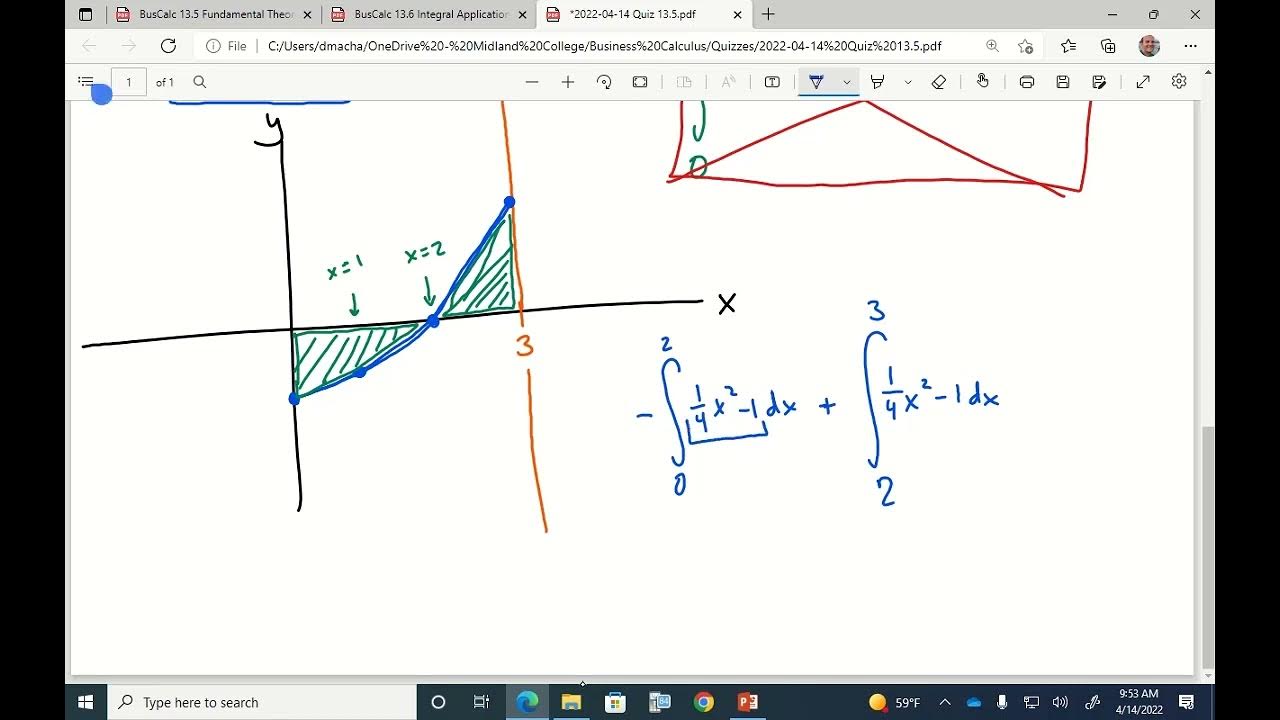Negative definite integrals | Integration and accumulation of change | AP Calculus AB | Khan Academy
TLDRThe video script discusses the concept of definite integrals, explaining how they represent areas below the x-axis as negative areas and how they relate to functions above or below the x-axis. It uses the analogy of velocity versus time graphs to illustrate how positive and negative velocities affect the change in position, thereby providing a clear understanding of the integral's sign in different scenarios.
Takeaways
- 📌 The concept of a definite integral from a to b represents the area below the function f(x) and above the x-axis.
- 📌 When a function lies below the x-axis, the definite integral represents the negative of the area below the function and above the x-axis.
- 📌 The sign of the definite integral (positive or negative) is determined by whether the function is above or below the x-axis within the given interval.
- 📌 In the context of velocity versus time graphs, the definite integral can represent the change in position.
- 📌 If the velocity function is positive (above the t-axis), the definite integral gives a positive value, indicating a rightward change in position.
- 📌 Conversely, if the velocity function is negative (below the t-axis), the definite integral is negative, indicating a leftward change in position.
- 📌 The area calculation for a definite integral is straightforward when the function is above the x-axis, as it directly corresponds to the physical area.
- 📌 For functions below the x-axis, the area must be considered as a negative value when calculating the definite integral.
- 📌 Understanding the sign of the definite integral is crucial for interpreting its physical or geometrical meaning in various applications.
- 📌 In future studies, more complex definite integrals may involve both positive and negative areas, requiring a combined calculation of these areas.
- 📌 The fundamental concept of definite integrals is to find the accumulated quantity (such as area, work, or change in position) over a specified interval.
Q & A
What does a definite integral represent in the context of the script?
-A definite integral represents the area under a function's curve between two points on the x-axis, specifically from point a to point b.
How is the area calculated when the function lies above the x-axis?
-When the function lies above the x-axis, the definite integral is equal to the signed area between the curve and the x-axis, with positive values indicating the area to the right of the y-axis.
What happens to the definite integral if the function is below the x-axis?
-If the function is below the x-axis, the definite integral is the negative of the area between the curve and the x-axis, indicating the area to the left of the y-axis.
How does the concept of definite integrals relate to velocity versus time graphs?
-In the context of velocity versus time graphs, definite integrals can be used to calculate the change in position over a given time interval, with positive velocities indicating movement to the right and negative velocities indicating movement to the left.
What is the significance of the definite integral being positive when a function is above the x-axis and a < b?
-A positive definite integral in this scenario indicates that the area under the curve is to the right of the y-axis, which corresponds to a positive change in position or a positive accumulation of quantity over the interval.
What is the significance of the definite integral being negative when a function is below the x-axis and a < b?
-A negative definite integral indicates that the area under the curve is to the left of the y-axis, which corresponds to a negative change in position or a decrease in the accumulated quantity over the interval.
How does the concept of definite integrals help in understanding integration properties?
-Definite integrals provide a foundation for understanding integration properties because they relate to the accumulation and depletion of quantities, which is a fundamental aspect of many mathematical and physical principles.
What is the calculation for the definite integral of v(t) = 3 meters per second from time t = 1 to t = 5?
-The calculation for the definite integral is the product of the constant velocity and the change in time, which is 3 meters per second times 4 seconds, resulting in 12 meters.
What is the calculation for the definite integral of v(t) = -2 meters per second from time t = 1 to t = 5?
-The calculation involves the product of the constant velocity (-2 meters per second) and the change in time (4 seconds), resulting in -8 meters, indicating a change in position to the left.
How does the script illustrate the concept of negative and positive areas in definite integrals?
-The script illustrates this by comparing the definite integrals of functions above and below the x-axis, showing that the sign of the integral reflects the area's position relative to the x-axis and the direction of the function's movement (left or right).
What is the role of the horizontal axis (x-axis) in determining the sign of the definite integral?
-The horizontal axis (x-axis) serves as a reference point to determine the sign of the definite integral. If the area is to the right of the y-axis and above the x-axis, the integral is positive; if it is to the left and below the x-axis, the integral is negative.
Outlines
📈 Understanding Definite Integrals and Area Calculation
This paragraph introduces the concept of definite integrals and their interpretation as areas under a function's curve. The instructor explains that if a function is above the x-axis, the definite integral from point a to b represents the area below the function. However, if the function lies below the x-axis, the area is considered negative. The explanation includes a visual representation of the function g(x) and its definite integral from point a to b, highlighting the importance of understanding the function's position relative to the x-axis when calculating the integral.
🚀 Applying Definite Integrals to Velocity and Time
The second paragraph delves into the application of definite integrals in the context of velocity versus time graphs. The instructor uses two scenarios to illustrate how the sign of the integral (positive or negative) corresponds to the direction of motion (right or left). The first example involves a positive velocity of three meters per second over a time interval, resulting in a positive integral representing a change in position to the right. The second example presents a negative velocity of two meters per second, leading to a negative integral, indicating a change in position to the left. The key takeaway is that the definite integral's sign reflects the area's position relative to the x-axis and the function's direction of motion.
Mindmap
Keywords
💡Definite Integral
💡Function
💡Area
💡x-axis
💡Negative Area
💡Velocity-Time Graph
💡Change in Position
💡Integration Properties
💡Horizontal Axis
💡Signed Area
💡Displacement
Highlights
Definite integral from a to b represents the area below the function f(x) and above the x-axis.
If the function lies below the x-axis, the definite integral represents the negative of the area between the function and the x-axis.
The definite integral is a measure of accumulation, whether it's above or below the x-axis.
The concept of definite integrals can be visualized geometrically as areas on a graph.
Definite integrals have applications in various fields, such as calculating the change in position from velocity versus time graphs.
When the velocity is positive, the definite integral represents the change in position to the right.
For negative velocity, the definite integral indicates a change in position to the left.
The sign of the definite integral (positive or negative) corresponds to the direction of the function relative to the x-axis.
A function above the x-axis and a < b results in a positive definite integral.
A function below the x-axis and a < b results in a negative definite integral, representing the opposite direction of accumulation.
Understanding definite integrals involves grasping the concept of areas both above and below the x-axis.
Definite integrals can be used to model real-world scenarios such as motion, where positive and negative values represent different directions of movement.
The geometric interpretation of definite integrals is crucial for their application in physics and engineering.
The explanation of definite integrals in the context of velocity and time graphs helps in understanding their physical significance.
The process of calculating definite integrals involves determining the area under the curve and considering the orientation of the function relative to the x-axis.
Definite integrals can be mixed, involving both positive and negative areas, which requires a more complex analysis.
Transcripts
Browse More Related Video

Area between a curve and the x-axis: negative area | AP Calculus AB | Khan Academy

Worked example: Merging definite integrals over adjacent intervals | AP Calculus AB | Khan Academy

What Is an Integral?

Definite Integrals from Graphs (Part 3 of 3) - Absolute Value

BusCalc 13.6 Integral Applications

Functions defined by integrals | Accumulation and Riemann sums | AP Calculus AB | Khan Academy
5.0 / 5 (0 votes)
Thanks for rating: